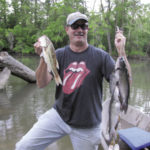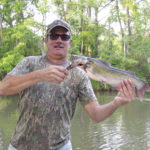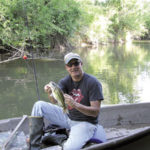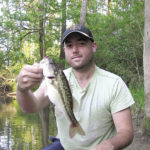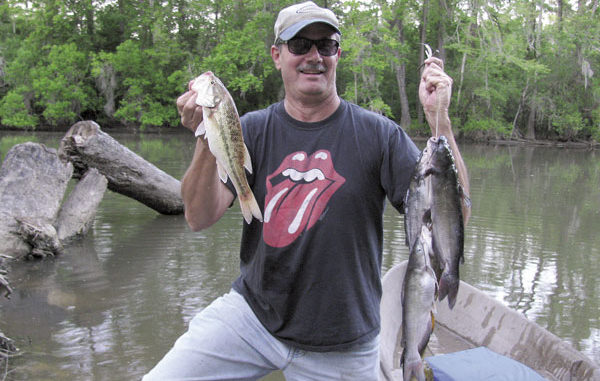
All you need is a pirogue and a few hours to put together a stringer of mixed deliciousness.
The gardeners (is that term permissible nowadays?) — OK, OK, I mean the landscapers spoke Spanish to each other and appeared to be Mexican (is that term permissible?) — OK, OK, I mean Hispanic.
Doc Fontaine’s brother had hired them to spruce up his spanking-new estate bordering the Honey Island Swamp (is that term permissible?) — OK, OK, I mean the Pearl River Basin wetlands.
Whatever.
The “landscape-sprucing” coincided with Trisha’s birthday-bash at the same locale, and the landscapers found themselves amidst what they probably took to be “rich gringos” (that term I know is permissible) seriously partying near picturesque Doubloon Bayou in Slidell, just off the West Pearl River.
Sipping on one of Doc’s famous margaritas, Priscilla felt compelled to prance from the gazebo, part from our unenlightened repertoire on the Saints and LSU, and engage the landscapers in hers. Priscilla fancies herself “bi-lingual,” but Pelayo and I have never managed to keep a conversation going with her in Spanish — not that we do much better in English. Two sentences into it, her eyes narrow. Three, and she starts snarling. Four, and she’s off in a huff.
Point is, she doesn’t seem to understand a lick of Spanish. She simply recites a few phrases, a few pleasantries, a few platitudes — and that’s it. Her Spanish lessons probably came from listening to Jose Feliciano’s “Feliz Navidad” and playing old Cheech and Chong records. So Pelayo and I nonchalantly followed her, claiming as an excuse that we wanted to check the water levels in the bayou as a key to the water levels in the Pearl.
Within seconds of approaching them, she started discharging her Spanish sound-bites at the bemused landscapers, who seemed to detect her unfamiliarity with their language. But the nonplussed Priscilla was in her glory. Here, in front of these humble and picturesque foreigners, was a perfect opportunity to display her open-mindedness, her lack of bigotry, her support for diversity and multiculturalism. The look on her face mimicked the girl with the flowers in her hair in the old Coke commercials (“I’d like to teach the world to sing …”).
And the landscapers themselves seemed immensely gratified. Their hurried comments to each other about “la gringa’s” physical attributes revealed a remarkable open-mindedness and appreciation in themselves.
But listening to them was painful for Pelayo and me. Our diaphragms were horribly strained while stifling guffaws. Pelayo’s lips were compressed and quivering. I was finally forced to cover my mouth in a mock cough.
But Priscilla was all smiles. These third-world denizens — so innocent, so pure — were obviously impressed by her worldliness, tolerance and compassion, said her glowing face.
When turning to Priscilla, the landscapers were all smiles. When they turned to each other, they also smiled — but now with an edge. When they noticed Pelayo and me, they reverted to the pleasant smile — not suspecting that we understood every word of their salacious fantasy. Certainly we were “rich gringos” ourselves (HA!).
“See what ya missed?” Pelayo smirked at Doc’s Chalmatian cousin-in-law Tommy (Nunez) who asked why we were still convulsed, red-faced and drooling when we returned to the gazebo.
“Shoulda talked more Spanish with your grandparents,” continued Pelayo, finally recovering his breath. “Kept up with your ancestor’s language. Now you’d be in on this joke. Heck, your ancestors technically came from Cuba. Louisiana was ruled from Havana at the time. The ships that brought over the Islenos all docked in Cuba first, where many ended up settling. Many Cubans have Isleno heritage.”
But nobody was in a mood for a history lesson. And the plans for the ‘morrow’s fishing trip took over as the sparkling repertoire until Eddie stumbled up.
“And remember, Tommy,” he started. “If you’d kept up with your grandparent’s Spanish, today you’d be a sophisticated multi-lingualist and multi-culturalist like Priscilla. And even better — a minority.”
Eddie grinned dementedly and pointed his margarita toward Pelayo and me with the comment, spilling about a third in the process.
“So you’d qualify for special government perks and favors like these two.”
Eddie was on his third margarita, so he was definitely prone to falsifications and spillings. Fully aware — from his florid face — of the factor involved, which rendered his stupid blatherings forgivable, Pelayo and I held our tongue.
But the wives didn’t.
“I WISH!” they shrieked from the gazebo area, where they obviously overheard Eddie’s comment about our (imaginary) government perks. The gals have had it in for Eddie for years — decades, actually. Something about making Tom Petty’s “You Got Lucky Babe,” the theme song of your wedding reception that just doesn’t seem to sit well with some women. Two divorces (from their friends) amidst two legal disbarments only solidified the view of many of the gals toward good ol’ Eddie, our Tigerland chum and indispensible buddy ever since. His “FOOD FIGHT!” John Belushi gig at a subsequent wedding reception didn’t help either.
After Eddie’s comment, some of the newer and more rustic guests were eyeing us suspiciously and with obvious distaste. That we admitted to be in on the landscapers joke just seemed to dig Pelayo and me deeper into a hole, which in fact one of the giggling gardeners was digging a few feet away for a fencepost. So we walked past him back to the bulkhead and water’s edge, and resumed the fishin’ talk, especially regarding panfishing in this area.
“Why waste your time?” snorted Artie who does most of his perch-jerkin’ in the Des Allemands/ Bayou Gauche area. “Most of the bedding is over by now.
“Come with us tomorrow. We’re taking Doc’s boat from here down to the Rigolets. Easy trip, and we’ll probably get on some nice specks.”
“Hah!” Pelayo retorted. “Heck, the panfishing’s just kickin’ in now around here.”
He whipped out his Blackberry, shoved it in front of Artie and Doc’s faces, and started showing off his stringers of Pearl River panfish from a recent trip. Rather than a box-a-mixed, as in the glory days, in the pics, Pelayo hefted a stringer-of-mixed goggleyes, bluegill, channel cats, “green trout,” yellow bass, even a couple of small sac-a-lait. Some were subsequently filleted, some be-headed and scaled — all emerged golden, crispy and delicious from the hot peanut oil.
The Pearl starts much farther north than the Tickfaw, Amite, Tangipahoa and Tchefuncte, and drains a much larger watershed. So it stays high longer than the others.
Tim Ruth, inshore fisheries biologist for the LDWF, backs Pelayo’s “just kickin’-in” quip with hard science. He concurs that fishing the Pearl River Basin has much in common with fishing the Atchafalaya Basin.
“The best fishing in the Pearl River Basin usually starts when river levels drop — and yes, that’s generally around June,” he said. “Of course, many people have been panfishing successfully for a couple months by then all over South Louisiana.
“But here in the Pearl you’ve got a fertile overflow swamp, which makes for a great food-source for panfish, on top of the fertile river waters themselves. Only hitch is you generally have to wait for them to drop a bit. The outflow from the Ross Barnett Reservoir affects the Pearl River levels and water turbidity. So it’s often unpredictable. But generally around June is when it starts getting good.”
Naturally when you think panfishing, you think of getting on bedding bluegills and other such fish. Again this kicks in later in the Pearl River Basin.
“The bluegills will generally start spawning when water temperatures hit 78-80 degrees,” explains Ruth, “which happens to the faster-flowing Pearl River waters generally later than in other South Louisiana lakes and bayous. But these fish will spawn up to three times a summer. So you’re likely to get on good bluegill beds till August in this area. And if the yellow bass had a good spawn in recent years, they can really be abundant in the Pearl. But there’s no predicting it. They’re not as consistently successful at spawning as other freshwater fish.”
In the interest of camaraderie, we hammered out a deal for the ‘morrow’s fishing trip. Pelayo and I would accompany Doc, Eddie and Artie for about a mile on the way to the Rigolets. They’d drop us off with pirogues at Mill’s Bayou, just off the West Pearl, and we’d panfish the morning away as they chased those ever-elusive Rigolets specks. We’d keep in touch cell phone wise, and they’d pick us up on the way in.
“Sound’s like a winnah!” exclaimed Doc.
“Feels like duck season!” laughed Eddie the next morning as we loaded two ‘rogues in Doc’s bay boat. Then he looked over and really laughed.
“Look at what this bozo’s gonna use!” he blurted while pointing at my utra-light pan-fishing rig: a jig under a cork — same as when we hunt specks, reds, puppy drum, sheepshead and flounder in our coastal marshes.
I lifted it and gloated.
“Now I sweeten it up with a little shrimp,” I said while grabbing the black/chartreuse mini jig. “Same principle, same rig — just cranked down a few notches for these smaller panfish.
“Y’all go ahead and knock yourselves out with your crankbaits and worms for green trout, have fun fumbling and fighting while trying to hook those crickets and worms for the panfish — me, I’m going with this.”
In fact, it’s hard to beat crickets and worms — and especially grass-shrimp — for Pearl River panfish ranging from bluegill to goggleye to channel cats to spotted bass. But a shrimp-sweetened jig usually catches just as many of the above, is easier to use and just seems more fun. It also strikes me as in perfect keeping with our brand of coastal fishing. Instead of casting a (bigger) shrimp-sweetened beetle-jig under a popping cork toward a current-washed point or island of cordgrass, you’re casting a shrimp-sweetened mini-jig, under a bobbing cork, toward a cypress knee, tupelo trunk or edge of alligator grass.
In fact my first cast, after Doc dropped us off, landed near an intersection of all three — and I didn’t even have time to pop the little cork. WHAM! — the bobber plunged and the battle was joined.
Now what kind of lunatic would describe the process of reeling in a half-pound fish on 6-pound-test line as a “battle?”
A fanatical panfishermen, that’s who. But in fact it was a bit more than a half pound — more like pound and a half, and though Pelayo hailed it as a “nice green-trout!” from his ‘rogue just behind me, Tim Ruth would call it a “spotted bass,” first cousin to the largemouth, whose range he overlaps here in the Pearl River Basin.
Whatever. The fillets would fry up gorgeously.
“Another one here!” yelled Pelayo, and I turned in time to see his spotted bass leap and cartwheel twice, then go into a frenzy of lunges and surface thrashing until Pelayo hoisted him aboard triumphantly. “Told you these little spinnerbaits were the ticket!”
In fact my shrimp-tipped mini jig caught just as many, plus the channel cats, goggleye, lakerunners (redears) and bluegill. Even a couple of (small) wayward sacs seemed to prefer my offering.
Not a quarter mile into our paddling, Pelayo pointed ahead. Three hogs were rumbling through the briars to our left. I shook my fist at them: “We’ll get ya next October! Why don’t you guys ever do this during daylight during the hunting seasons?”
The scenery and the catching had gotten us giddy. The tide was starting to drop now, and a nice little rip had formed at the mouth of a little slough emptying into Mill’s Bayou (which isn’t much more than a little slough itself). The water colors clashed like tea clashing with a McDonalds coffee.
My little bobber hit near the rip, bobbed twice, twirled in the current, and vanished as it neared a tupelo trunk.
“Hey, hey!” I yelled as I set the hook.
Then he started tugging and lunging, and finally thrashing the surface. In minutes I hoisted a gorgeous channel cat toward Pelayo, who seemed impressed. So he paddled over, switched to a shrimp-tipped mini jig, and cast near my “honeyhole.” His cork didn’t last long afloat.
“YEAH!” he beamed as his little reel started singing. “They’re here podnuh!”
But his wasn’t jumping, just slashing back and forth, a little surface thrashing. Then back under for some spirited runs. I swung in a big bluegill as Pelayo jerked aboard his chunky goggleye (these ain’t nearly as big as Atchafalaya Basin goggleyes — but still nice). The little sucker wasn’t 10 inches long. But we were all smiles.
My next cast nailed a little yellow bass within seconds of hitting the water. Pelayo was on another bluegill in short order. Then his drag started singing — “Oh, oh!” he frowned. “Looks and sounds — like a choupique!”
Instead he was soon dipping the net under another perfect-sized channel cat. Then came a chunky lakerunner. Down in the marsh these start spawning as early as December. In these upper reaches, they’re still ravenous in June.
My next fish after re-sweetening my jig was another big red-bellied bluegill. All these panfish seem to like the same type of food flowing from this overflow swamp or drifting along the maze of sloughs and bayous that form the distributary system of the Lower Pearl River Basin, whose scenery attracts tourists from around the world. Our shrimp-tipped jigs seemed to perfectly mimick this panfish feast, and we were amply rewarded with a couple dozen delicious panfish during an immensely enjoyable “swamp-paddle.”
The most fun came when Doc and the gang picked us back up, and we looked in their “box.” Guess who provided most of that night’s fish-fry “fixins”?
